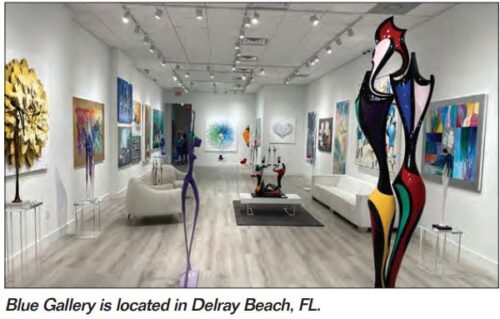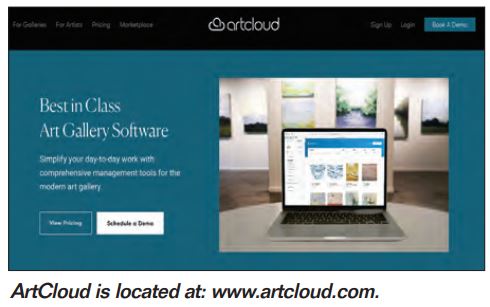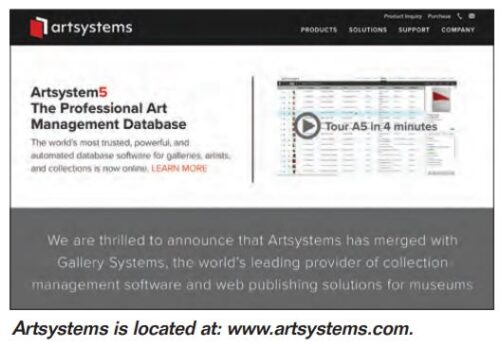I often contribute to Art World News and I wanted to share with you one of their articles about what art galleries and frame shops are looking for in art gallery business management software today. This article was written by Koleen Kaffan, who is Editor in Chief of Art World News and offers some excellent insights that I hope will help you make the best decisions for your gallery business.
 The value that business management software brings to art and framing retailers has been proven over the years—track inventory, manage sales, build customer profiles, maintain social media accounts, e-commerce and multichannel selling—but today, it is vital to helping them embrace the changing marketplace and adapt to consumers’ buying behaviors. While the industry is well-versed in what the Covid-19 pandemic has done to the way in which people make purchases, it has also made developing personal relationships with them even more important. Having access to the business on a one-on-one basis has helped to create lasting relationships and sales that used to be made face-to-face. And for retailers, being able to access their own software, digitally, from anywhere due to cloud-based software has helped develop fluidity in that bond and create a customer-centric experience.
The value that business management software brings to art and framing retailers has been proven over the years—track inventory, manage sales, build customer profiles, maintain social media accounts, e-commerce and multichannel selling—but today, it is vital to helping them embrace the changing marketplace and adapt to consumers’ buying behaviors. While the industry is well-versed in what the Covid-19 pandemic has done to the way in which people make purchases, it has also made developing personal relationships with them even more important. Having access to the business on a one-on-one basis has helped to create lasting relationships and sales that used to be made face-to-face. And for retailers, being able to access their own software, digitally, from anywhere due to cloud-based software has helped develop fluidity in that bond and create a customer-centric experience.
But meeting all of the needs of art and framing retailers is an evolving process. Katherine Hébert, owner of Gallery Fuel (www.galleryfuel.com), an online art gallery business consultancy and business advisor, says that the quick pace of these changes has been intimidating for some. “Art galleries struggle to implement their sales and marketing processes with rapidly changing digital tools,” she says. “Every year, there is something new that can make doing business more powerful and/or allow them to reach a larger audience. Gallery software must make this part of the job easier. My clients are running their businesses with a tiny staff and they have all the same responsibilities that have existed in the industry forever. Now they must also keep up with the demands of producing content for multiple channels, measure the effectiveness of that content, continuously provide fresh ‘experiences’ for discovering and viewing art, and communicate with clients through various apps. This has created much frustration.”
But turning to a software program can help to sort it all out. “Retailers adopt a program to help streamline many of their processes and have vital information with them at all times as they travel and network outside of the gallery,” Ms. Hébert says. “Most gallery software programs, at a minimum, help keep inventory and client records organized and information at their fingertips. Some also integrate website development, e-mail marketing capabilities and e-commerce options.”
Customizing a gallery’s needs is also important. “Sometimes the capabilities of these features are minimal, and it makes sense for a gallery to use multiple programs with similar characteristics. A good example might be e-mail marketing programs. As a result, a gallerist must learn numerous programs. That costs time and money, both of which are in short supply.”
As e-commerce continues to grow, cloud-hosted point-of-sale (POS) programs are a necessity for all businesses, large and small. An advantage to this type of software is that it automatically backs itself up and can sync data in the cloud using a remote server, thus making it easier to protect and update information.
Business management consulting company, Retail Consulting Partner, released a survey in 2020 stating that 52% of corporate organizations are already using cloud-based POS and that 40% more are planning to do the same. This also means that many retailers are opting for iPads and tablets rather than tabletop computers to run their business.
 Alex West, CEO of ArtCloud (www.artcloud.com), located in Atlanta, GA, says that while technology is ever-changing, retailers really need software that they can effectively use every day. ArtCloud is an integrated art management (inventory, CRM, marketing e-mails, etc.) and website software for the art world.
Alex West, CEO of ArtCloud (www.artcloud.com), located in Atlanta, GA, says that while technology is ever-changing, retailers really need software that they can effectively use every day. ArtCloud is an integrated art management (inventory, CRM, marketing e-mails, etc.) and website software for the art world.
“Covid brought a surge of online activity,” he says. “Since then, we’re seeing that galleries and artists need a comprehensive and easy-to-use platform to manage their gallery, both online and in-person.
Mr. West says that recent software updates help to reflect the needs of the industry. “We’ve done a lot of updates over the last two years. We’ve rebuilt our website builder from the ground up to give our customers even more control over their websites. We have also launched e-mail campaign functionality that lets the user easily create and send custom e-mail campaigns to targeted client segments. An integrated and easy-to-edit website has to be the number one customer need. Beyond that, a robust platform and a great support team helps ensure all of our customers have a great experience.”
Mr. West says that the pandemic created a different retail world that brought with it much opportunity. “We’ve seen a lot of galleries’ business explode over the past two years. As the macro-economic climate provides headwinds, I think the galleries that embrace technology will continue to thrive,” he says. “The galleries that are coasting and hoping customers will keep coming back (without strategic outreach) will struggle to maintain their revenue. We’re doubling down on our platform development. We’re also launching a new professional services program to help build websites for our customers that are nervous to undertake the effort themselves.”
Another aspect that retailers must be able to handle today is doing business cashless. POS software that allows them to accommodate mobile payments and digital wallets helps ensure that sales are met without obstacles.
At Artsystems Inc. (www.artsystems.com), New York, NY, managing partner Doug Milford, says that being able to close sales via the internet is part of doing business today. “Our clients are working and selling more online,” he says. “As the internet has become ubiquitously available, the ability to work from anywhere, anytime—efficiently communicating with clients —has become essential. We have implemented a free Sales Pipeline tool for managing the sales workflow, thus making, creating and tracking offers extremely easy from within our Artsys-tem5 (A5) software. We have also established efficient integration with a growing list of third-party online service providers, including Articheck (for condition reporting), QuickBooks (for accounting) and an exciting upcoming integration for online sales.”
 Mr. Milford says that during the pandemic, retailers needed to adapt quickly to the changing environment and that using software was like having another employee on the team. “Working during Covid forced art businesses to utilize online platforms that allowed them to work and sell from anywhere. Even as they closed their doors due to shutdowns, they continued to run their businesses successfully, learning how to reach out to the broader global audience, growing their client base significantly.
Mr. Milford says that during the pandemic, retailers needed to adapt quickly to the changing environment and that using software was like having another employee on the team. “Working during Covid forced art businesses to utilize online platforms that allowed them to work and sell from anywhere. Even as they closed their doors due to shutdowns, they continued to run their businesses successfully, learning how to reach out to the broader global audience, growing their client base significantly.
“Post-Covid, they continue to benefit from this expansion of their markets, along with the flexibility and efficiencies that our web-based software, A5, and our integrated websites, provide.”
Updates revolve around addressing a business’ need to be as streamlined as possible. “As always, our clients need efficient internal database integration that saves time, leverages information, tracks activity appropriately and ensures accuracy,” he says. “Beyond that, they need to integrate their database online with their own website and artwork display app, along with third-party providers.”
Update priorities for Artsystems includes expanding website capabilities. “We are creating a new website product for our customers to integrate directly with their own flexible and customizable websites. We will also be expanding the feature that automates and integrates all aspects of running an art gallery, and expanding the list of service providers that integrate with our database software.”
This type of integration, Mr. Milford says, is what retailers are looking for today. “Our A5 software’s ability to integrate all information management processes—where every edit updates related records within the database and with online integration with their own website and service providers —is becoming increasingly important in today’s fast-paced online business environment.”
Art and framing retailers that offer multichannel buying opportunities—brick-and-mortar business, e-commerce, cashless sales, etc.—have been able to thrive during the pandemic and this trend has continued today as more customers are now comfortable with these options. A recent report by market research company, eMarketer, says that multi-channel online retailers generated more than $350 billion in e-commerce sales in the United States in 2020. Not continuing with this trajectory would be leaving money on the table.
In the art and framing marketplace, personal connections with customers helps lead to repeat sales which is the lifeblood of the industry. Retailers that make consumers feel valued with personalized service and shopping experiences, quick responses, recommendations, etc., bring in long-term sales.
Paul O. Thomas, president of LifeSaver Software Inc. (www.lsscloud.com), Canton, GA, says that accessibility, both in and out of the gallery, is how business is conducted today. There has been a move towards more mobility and website-based software,” he says. “We have moved to a cloud POS so our customers can run it from wherever and using whatever device they wish to. They can run on a tablet, such as an iPad or inexpensive android tablet, on a Mac or PC. Anything that can touch the internet. This gives them the flexibility needed to operate from home or in a customer location. We have also created a web framing add-on so anyone can add framing to their existing website. They don’t even need to be a current LifeSaver customer. It is an inexpensive way for them to compete with the larger online framing sites.”
Updates for LifeSaver also reflect the changing way that sales are made. “In addition to the website framing and cloud-based POS, we are currently adding gift cards to our preferred credit card processor, EVO Payments. We believe that those frame shops that have adopted additional ways of doing business are the ones that have thrived during this Covid and post-Covid time. Customers are getting used to doing business online so some of our frame shops have adapted by adding framing options and e-commerce to their websites.”
Mr. Thomas says that the customer profile in today’s world reflects one that is much more comfortable with technology as it was a necessity during the pandemic. Many interactions with a business begin with a website search. “Art and framing retailers are looking for a more modern approach to the evolving market that includes something beyond a simple informative website,” he says. “Having a more interactive site that allows the customer to purchase from them from home at whatever time they feel like shopping is important.”
For LifeSaver, keeping an eye on shopping trends and marketplace strategies helps them develop updates. “Our priorities have always been pouring resources into development to provide our customers with more comprehensive, simple tools for generating more business. Better rates on their processing, e-commerce, flexible POS with visualization and simple, in-expensive website framing are vital.
We have always tried to provide tools to our galleries and frame shops that make doing business easier and more profitable. This will continue to be our focus,” Mr. Thomas says. “With the major operating systems moving rapidly towards ‘cloud-based’ programs, we made the decision years ago to move to the cloud so our customers won’t be left behind like the standard software programs that reside on a hard drive.”
Looking to the coming year, Ms. Hébert says that integration is key. “I think galleries will be looking for software programs that can better streamline or integrate the tools needed to implement different aspects of running the business, i.e., sales, marketing, and operational workflows. I work with many galleries that are only using a fraction of their chosen program’s capabilities or are at a loss for how to get the software set up correctly for their goals. Better training and more intuitive design are becoming essential considerations for software selection,” she says.
Doing research and choosing the right program or programs are key. “I recommend that gallery owners sit down and look at all the different pain points in their day-to-day running of the business and within their processes. Also, look at individual administrative tasks that take time away from working with your artists and clients. Make a list and determine if any of those can be better automated using gallery software,” Ms. Hébert recommends.
“If a gallery is online-only, some features that enhance digital presentations of artworks will be critical. Involve your staff in the process and ask questions about what is in the development stages for the software company. Some programs are very powerful. They can be a wise investment, but only if you take the time to use them comprehensively.”
Since this can be a daunting task, a company like Ms. Hébert’s Gallery Fuel can help to refine the search by concentrating on what is most important for the business. “When Gallery Fuel works one-on-one with a new gallery, or one still using e-mail and spreadsheets to organize their business, I always advise adopting gallery-specific software,” she says. “As a business tool, it makes selling art and providing excellent customer service much easier. I help my clients optimize these systems for their gallery’s specific needs and resources so they can quickly locate their best leads, personalize sales conversations and create workflows for how best to use the features of their chosen software.”
Koleen Kaffan is Editor in Chief of Art World News.


Leave a Reply